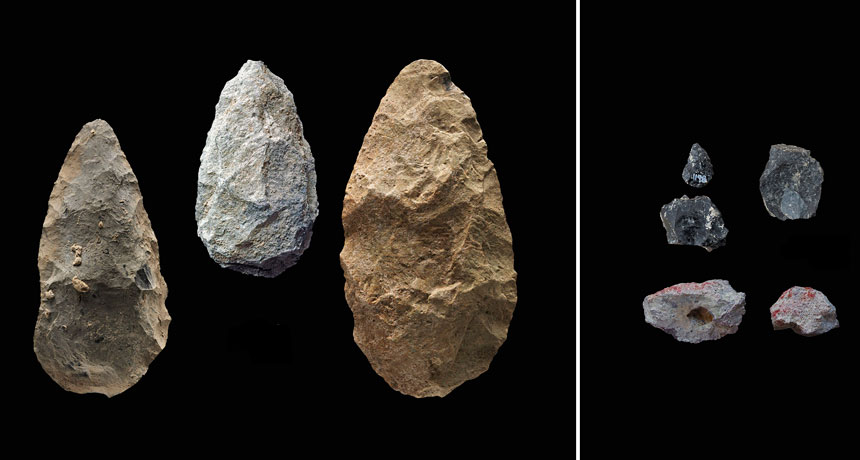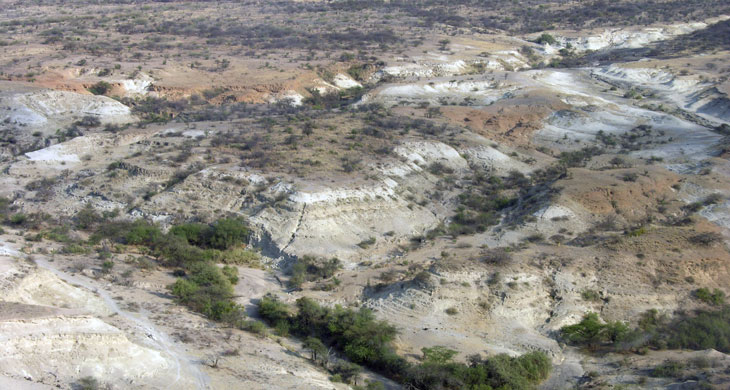Ancient climate shifts may have sparked human ingenuity and networking
Stone tools suggest rise of humanlike behaviors by 320,000 years ago

TOOLING DOWN By around 320,000 years ago in East Africa, Homo sapiens or a close relative had shifted from making large chopping implements (left) to fashioning spearpoints and other small tools (right).
Human Origins Program/Smithsonian
Dramatic shifts in the East African climate may have driven toolmaking advances and the development of trading networks among Homo sapiens or their close relatives by the Middle Stone Age, roughly 320,000 years ago. That’s the implication of discoveries reported in three papers published online March 15 in Science.
Newly excavated Middle Stone Age tools and red pigment chunks from southern Kenya’s Olorgesailie Basin appear to have been part of a long trend of climate-driven behavior changes in members of the Homo genus that amped up in H. sapiens. Locations of food sources can vary unpredictably on changing landscapes. H. sapiens and their precursors responded by foraging over larger areas with increasingly smaller tools, the researchers propose. Obsidian used for the Middle Stone Age tools came from far away, raising the likelihood of long-distance contacts and trading among hominid populations near humankind’s root.
At roughly 320,000 years old, the excavated Middle Stone Age tools are the oldest of their kind, paleoanthropologist Rick Potts and colleagues report in one of the new papers. Researchers had previously estimated that such tools — spearpoints and other small implements struck from prepared chunks of stone — date to no earlier than 280,000 to possibly 300,000 years ago. Other more primitive, handheld cutting stones made of local rock date from around 1.2 million to 499,000 years ago at Olorgesailie. Gradual downsizing of those tools, including oval hand axes, occurred from 615,000 to 499,000 years ago, a stretch characterized by frequent shifts between wet and dry conditions, the scientists say.
It’s not known whether that tool trend continued or if a sudden transition to Middle Stone Age implements happened between 499,000 and 320,000 years ago. Erosion at Olorgesailie artifact sites has destroyed sediment from that time period, leaving the nature of toolmaking during that time gap a mystery. Age estimates relied on measures of the decay of radioactive forms of argon and uranium in volcanic ash layers framing tool-bearing sediment. It’s unclear whether Homo sapiens or a closely related species made Olorgesailie’s Middle Stone Age tools, since no hominid fossils have been found there.

A substantial number of Olorgesailie’s Middle Stone Age tools are made from obsidian that came from at least 25 to 50 kilometers away from the excavation sites. At one Olorgesailie site in particular, 42 percent of more than 3,400 stone artifacts were obsidian. Some of those finds display signs of having been attached to handles, likely as spearpoints, a group led by archaeologist Alison Brooks of George Washington University in Washington, D.C., reports in the third paper. Brooks is also a coauthor on the other studies.
Formation of trading networks among dispersed groups of H. sapiens, or possibly among closely related populations, best explains how large amounts of obsidian turned up at Olorgesailie by 320,000 years ago, contends Potts, who coauthored the third paper. “Social networking during a long period of climate variability was a key to success for early Homo sapiens,” he says. “Greater mobility encouraged inventive thinking about how to acquire resources.” Potts has long argued that H. sapiens and close evolutionary relatives evolved to deal with constantly changing environments (SN: 8/20/05, p. 116).
Still, factors other than climate fluctuations, such as hominid population declines or surges, may also have spurred ancient tool innovations to acquire more or different types of food, cautions archaeologist Yonatan Sahle of the University of Tübingen in Germany.
In addition to the obsidian tools, a total of 88 pigment lumps, including two pieces with grinding marks, came from an undetermined distance outside the Olorgesailie vicinity, Brooks’ group says. Pigment applied to one’s body or belongings may have signaled group identity or social status, the researchers suggest.
The new reports fit with genetic evidence that H. sapiens originated in Africa between 350,000 and 260,000 years ago (SN: 10/28/17, p. 16), says Stone Age archaeologist Marlize Lombard of the University of Johannesburg. Smaller, more specialized Middle Stone Age tools appearing along with pigment “provide strong indicators that by around 300,000 years ago we were well on our way to becoming modern humans in Africa,” she holds.
Ancient toolmaking approaches varied greatly from one part of Africa to another, with hominids employing diverse mixes of old-school chopping tools and newer, sharp points, says archaeologist John Shea of Stony Brook University in New York. At Olorgesailie and elsewhere, he says, “early Homo sapiens and their immediate African ancestors were at least as smart as the scientists investigating them.”
Editors’ note: This story was updated on March 21, 2018, to correct the percentage of stone artifacts made from obsidian at one Olorgesailie site.







